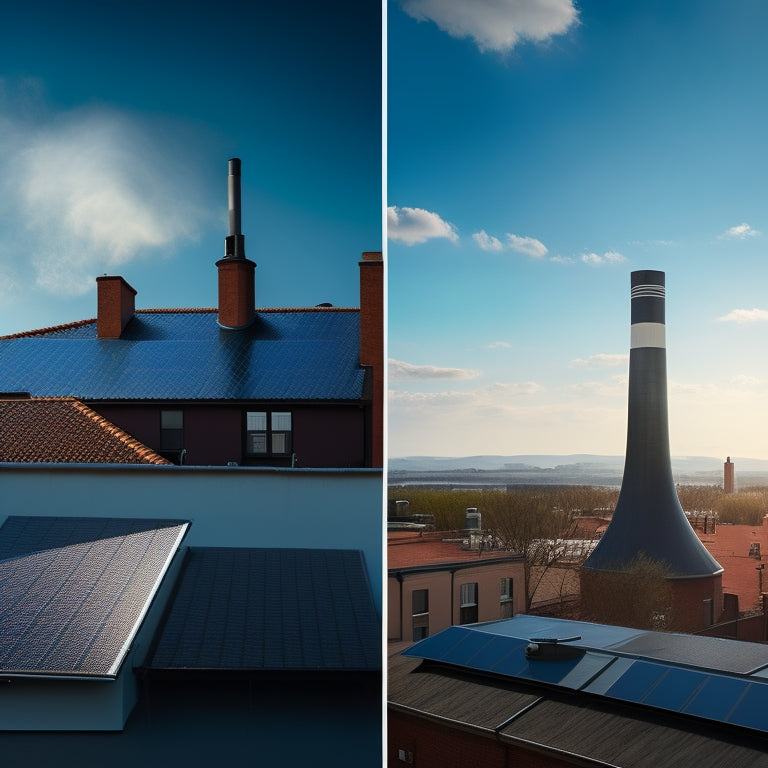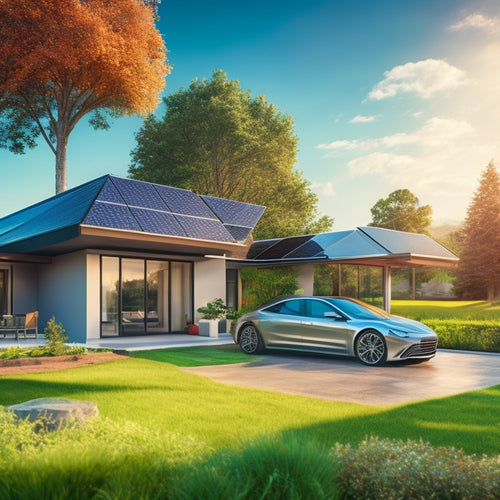
Cost of Switching to Solar Energy Essentials
Share
You'll find that the overall cost of switching to solar energy essentials is influenced by several key factors. The type and quality of solar panels, inverters, and mounting hardware all play a role, as do labor and installation expenses. Additionally, permits and inspection fees will add to your total cost. You'll need to evaluate the type of inverter, battery prices, and roof and mounting fees, which vary based on roof design complexity and material. Understanding these components will help you better budget for your solar energy system. As you investigate your options, you'll uncover even more details that can impact your final cost.
Key Takeaways
- The type and quality of solar panels significantly impact the total cost, with monocrystalline panels being the most expensive.
- Labor costs account for 10% to 20% of the total system cost, but financing options can help spread the upfront costs.
- The choice of inverter type affects the overall system cost, with string inverters being the most cost-effective option.
- Roof and mounting fees vary based on roof design complexity and mounting type, with flat roofs and metal roofs requiring more expensive systems.
- Permit and inspection costs, ranging from $1,000 to $3,000, are essential to budget for to ensure compliance with safety and electrical codes.
Understanding Solar Panel Costs
Your solar panel cost is a significant investment, and understanding its components is essential to making an informed decision. The overall cost of solar panels depends on the type and quality of the system you choose.
There are several solar panel types, including monocrystalline, polycrystalline, and thin-film panels, each with its own efficiency ratings and price points. Monocrystalline panels are the most efficient but also the most expensive, while thin-film panels are the least efficient but most affordable.
When considering your solar panel cost, you'll need to factor in the cost of the panels themselves, as well as the inverters, mounting hardware, and installation equipment.
Fortunately, there are various financing options available to help make solar energy more accessible. You can investigate options like cash purchases, loans, or power purchase agreements (PPAs) to find a financing solution that fits your budget.
Understanding the different components of your solar panel cost and investigating financing options will help you make an informed decision and guarantee a successful shift to solar energy.
Installation and Labor Expenses
As you move to solar energy, setting up the system is a crucial step that requires significant investment. The installation process involves various labor-intensive tasks, including evaluating your roof's structural integrity, designing the system, and connecting the panels to the electrical grid.
These tasks demand specialized skills, equipment, and knowledge, which come at a cost. On average, installation and labor expenses account for around 10% to 20% of the total solar energy system cost.
To make the shift to solar energy more accessible, many providers offer financing options, such as loans or power purchase agreements, to help spread the upfront costs over time.
It's important to factor in maintenance costs when calculating the overall expense of moving to solar energy. Regular maintenance guarantees the system operates at peak efficiency, maximizing your energy output and reducing the likelihood of costly repairs down the line.
Inverter and Battery Prices
With the installation and labor expenses accounted for, it's essential to evaluate the cost of the system's core components, specifically the inverter and battery prices.
You'll need to take into account the type of inverter that suits your system, as it affects the overall cost. String inverters, microinverters, and power optimizers are the main inverter types, each with its own price range. String inverters are the most common and cost-effective option, while microinverters and power optimizers offer more flexibility and monitoring capabilities at a higher cost.
When it comes to batteries, you'll want to reflect on their lifespan, depth of discharge, and overall capacity. A higher-capacity battery with a longer lifespan will cost more upfront but provide more energy storage and reduce replacement costs in the long run.
On average, a solar battery can last between 5 to 15 years, depending on the quality and brand. You'll need to weigh the upfront cost against the long-term benefits of a high-quality inverter and battery system.
Roof and Mounting Fees
Three vital components of the overall solar energy system cost are the roof and mounting fees, which can vary considerably depending on the complexity of your roof's design and the type of mounting system required.
For instance, if you have a flat roof, you'll need a ballasted mounting system, which is more expensive than the standard rail-mounted system used for pitched roofs. The type of roof material also plays a significant role in determining the mounting fees. For example, if you have a metal roof, you'll need specialized clamps and flashing, adding to the overall cost.
Additionally, the size and complexity of your solar panel array will impact the mounting fees. A larger system will require more mounting hardware, increasing the cost.
You may also need to take into account additional components, such as roof anchors or solar trackers, which can further increase the fees. Understanding the specifics of your roof and mounting requirements is essential in determining the overall cost of your solar energy system.
Permits and Inspection Charges
You'll need to factor in permits and inspection charges when calculating the total cost of your solar energy system. These costs can vary depending on your location, system size, and local regulations.
Typically, you'll need to obtain a building permit and an electrical permit before installing your solar panels. The permit application process usually involves submitting your system design and installation plans to your local government for approval.
The cost of permit applications can range from $500 to $2,000, depending on the complexity of your system and the jurisdiction. Additionally, you'll need to comply with inspection requirements, which may involve multiple site visits from local authorities.
These inspections guarantee that your system meets safety and electrical codes and can cost between $500 to $1,000. It's crucial to include these costs in your budget to avoid unexpected expenses.
Be sure to research the specific permit and inspection requirements in your area to get an accurate estimate of these charges.
Frequently Asked Questions
Can I Install Solar Panels on My Own to Save Money?
You can attempt a DIY installation, but it's vital to understand the intricacies of solar panel types, such as monocrystalline and polycrystalline, and make certain you meet local electrical codes and safety standards to avoid potential risks and voiding warranties.
Do Solar Panels Work During Power Outages or at Night?
Fast-forward to a world like ancient Greece, where candles lit the way at night - but you won't need those with solar energy storage! You'll enjoy grid independence, as your panels store excess energy for nighttime use or power outages, keeping you lit and connected.
How Long Does It Take to Break Even on Solar Panel Investment?
You'll reach solar payback in 5-7 years, depending on your energy usage and local incentives, after conducting a thorough investment analysis to determine when your savings will outweigh the initial cost of going solar.
Are There Any Tax Credits or Incentives for Switching to Solar?
As you step into the radiant world of solar power, you'll uncover a wealth of benefits, including federal incentives and local rebates that'll help you shine brighter, with the Solar Investment Tax Credit (ITC) being a shining star, offering up to 26% of your total system cost back in your pocket.
Do Solar Panels Increase My Home's Resale Value?
You'll be happy to know that installing solar panels can enhance your property value, as they're seen as a desirable feature, increasing your home's appeal to potential buyers and potentially adding thousands to its resale price.
Related Posts
-

What Solar Panels Work Best With EVS Online?
When shopping for solar panels online to power your electric vehicle, look for high-efficiency models that can withst...
-

10 Essential Bike Lane Safety Features to Consider
You're designing a bike lane with safety in mind, and that's essential. The National Highway Traffic Safety Administr...
-

Top 7 Portable Solar Car Battery Solutions Online
You're in luck with our selection of reliable portable solar car battery solutions that meet your needs and budget. O...


